
Disease(s): Common Foliar Diseases of Alliums
This fact sheet discusses botrytis leaf spot (Botrytis squamosa), purple blotch (Alternaria porri), stemphylium leaf blight (Stemphylium vesicarium) and downy mildew of onion (Peronospora destructor). These are the most commonly occurring foliar diseases of alliums in the Northeast, and many of their disease dynamics are closely linked; if one of these diseases is present, it’s common to find three or four of them at the same time. Organic management of these diseases is similar, but it’s important to know the differences between the diseases to help inform the timing of your management choices.
Pest/disease identification and lifecycle:
Botrytis leaf spot is caused by the pathogen Botrytis squamosa. Botrytis neck rot, a common storage disease of onions, can be caused by any one of three other species of Botrytis (B. cinerea, B. porri or B. allii). B. squamosa overwinters in crop debris and in the soil as sclerotia, hardened black masses of mycelia that are adapted to withstand extreme conditions, and can survive several months. As conditions warm in the spring, those sclerotia form conidia, an airborne spore that serves as inoculum for the disease in the new growing season when wind carries it to new plantings. These spores can also form on leaves of resprouting infected bulbs in cull piles or compost piles that haven’t reached killing temperatures. Botrytis spores require long periods of leaf wetness or high humidity and temperatures between 55 and 75 F to germinate and cause disease. Unlike Alternaria and Stemphylium, B. squamosa is able to infect healthy leaf tissue relatively easily. Spores of B. squamosa can infect by forming an appressorium — a specialized fungal structure that can penetrate the leaf surface — or hyphae can directly enter the leaf through microscopic pores in leaf surfaces called stomata.
Allium downy mildew is caused by Peronospora destructor, which is a fungus-like organism in the class Oomycota. Downy mildew also produces airborne conidia during cool (52-72 F) and wet (at least 95% humidity) weather conditions. These cool and wet conditions are also the most favorable to these spores’ successful germination and infection of otherwise healthy leaves. A spore can infect a wet leaf in only two to three hours in conditions below 61 F, but requires five hours of leaf wetness between 61 and 68 F. The pathogen cycle, from initial infection to sporulation, takes between one and two weeks depending upon conditions, allowing the disease to spread quickly between and within fields under the right conditions.
Purple blotch is caused by Alternaria porri, while stemphylium leaf blight is caused by Stemphylium vesicarium, two fungal organisms in the same family. Because these two pathogens cause very similar diseases, and because their management is largely the same, especially in organic growing, you may see them both referred to as a single disease: purple blotch. Purple blotch and stemphylium leaf blight both infect plants through injuries in the leaf surface caused by mechanical damage, extreme weather, thrips, or prior infection such as botrytis leaf spot. Both pathogens overwinter in crop debris, and in nearby weed debris (especially wild alliums) releasing airborne spores called conidia in the spring to be carried by wind. Alternaria disease progression is favored by hot weather (77-85 F), while stemphylium leaf blight is favored by warm weather (72-77 F). It can take as few as five to six days for new lesions from either disease to begin producing spores, depending on conditions. These airborne spores from new lesions can then spread, causing secondary infections throughout the season.
Damage and crops affected:
These four diseases are all specialists of alliums, meaning that they can infect nearly any allium including onions, garlic, shallots, chives and leeks, along with many wild allium species, which can act as reservoirs for the diseases. Importantly, botrytis leaf spot is often the initial entry point for downy mildew, stemphylium leaf blight and purple blotch, as it can create injuries in the plant and weaken the plant such that its defenses are diminished. Even in minor infections, all of these diseases can impact sales of leeks and chives because the lesions occur on the salable part of the plant. Minor infections can also stunt plant growth and bulb size in onions, garlic and shallots. Any of these initial infections can also create opportunities for secondary infection both in the field and in storage. In severe infections, any of these pathogens can progress to total collapse of the plant before harvest. Beyond creating opportunity for secondary infections in the bulb, downy mildew can directly infect the bulb in systemic infections. Purple blotch and stemphylium, in severe instances, can also attack and girdle seed stems in allium seed crops.
Management options:
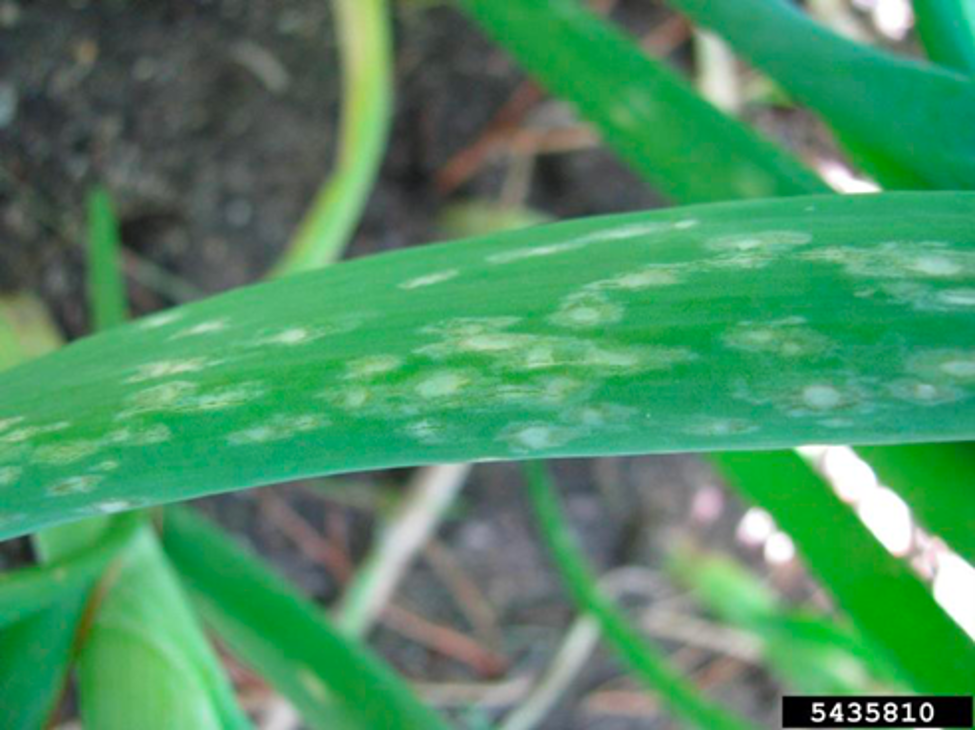
Scouting:
Especially during weather conditions that promote the successful infection and spread of these diseases, it’s advisable to scout for symptoms to inform timing of management choices. In dry weather, with good cultural management, these diseases are fairly limited. In cool, wet weather (65-77 F), botrytis leaf spot and downy mildew are more likely to emerge, and stemphylium leaf blight may follow. Purple blotch is more common in warmer wet weather (77-85 F).
Early symptoms of botrytis leaf blight are approximately ¼-inch oval-shaped silvery halos, which are easier to see when the leaf is wet (fig. 1). Necrotic spots will eventually form within the halos. Often, these spots can be confused with thrips damage — however, thrips damage does not present with the telltale halos. In rare instances, botrytis leaf spot can become so severe that spots grow larger, tan, and ultimately coalesce.
In fields, downy mildew often first appears as circles of yellowed plants measuring a few feet in diameter (fig. 2). On individual infected leaves, pale spots develop, then begin to turn a brown or purple hue. When plants are wet, or conditions are humid, fuzzy gray-white growths are visible, emerging overnight and often “burning off” in clear sunny conditions. This sporulation gives this disease its name — downy mildew (fig. 4). In systemic infections, leaves first become paler green, then yellow to brown, and then die back entirely, and plants are often stunted and distorted. Violet lesions may appear, but the disease can be differentiated from purple blotch by this fuzzy mycelial growth, systemic yellowing of the plant, and by spongy, shriveled or watery bulbs.
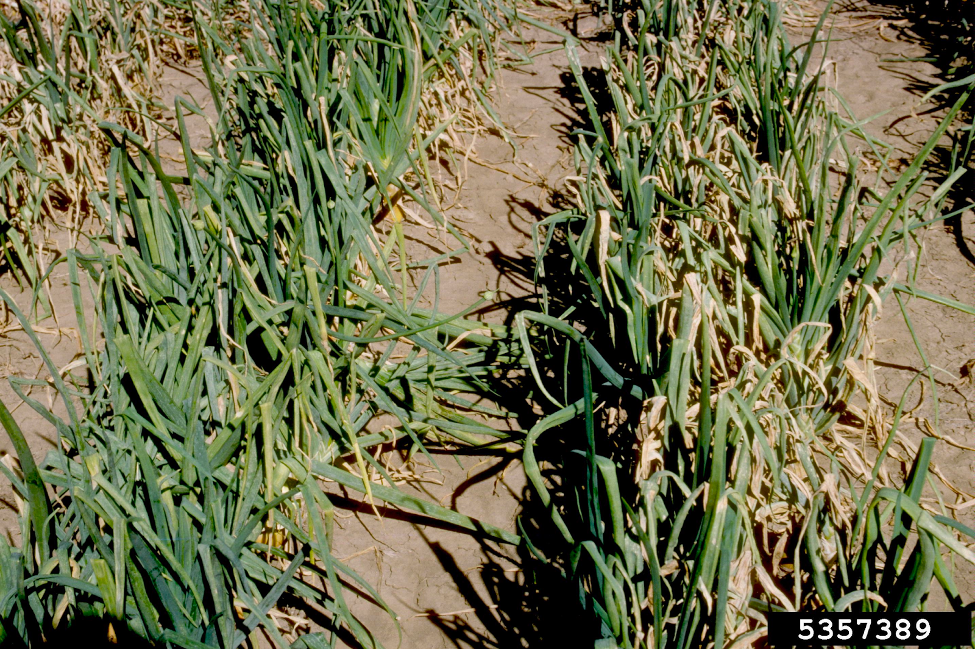
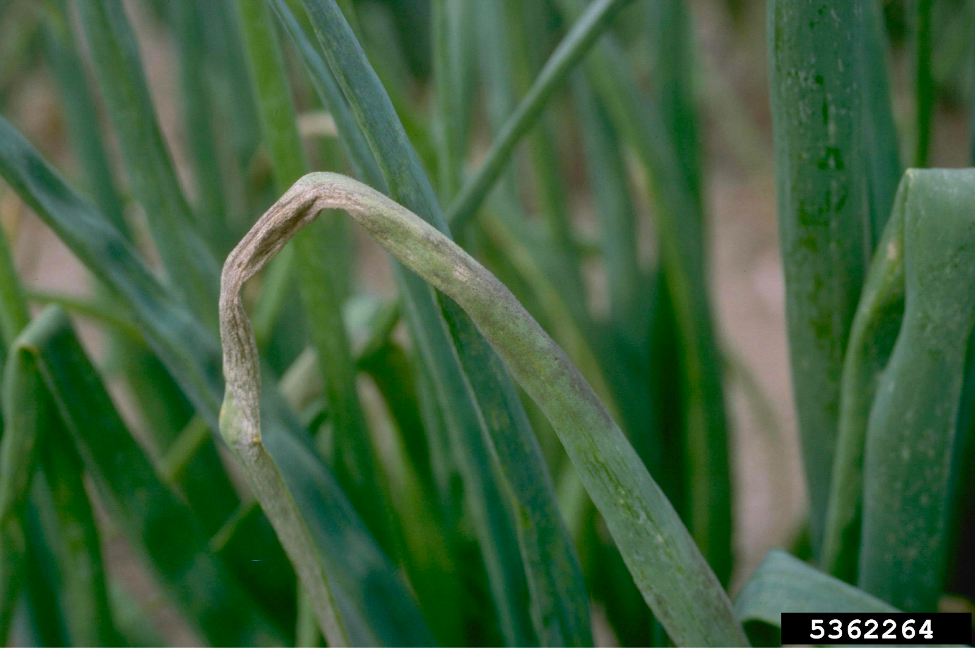
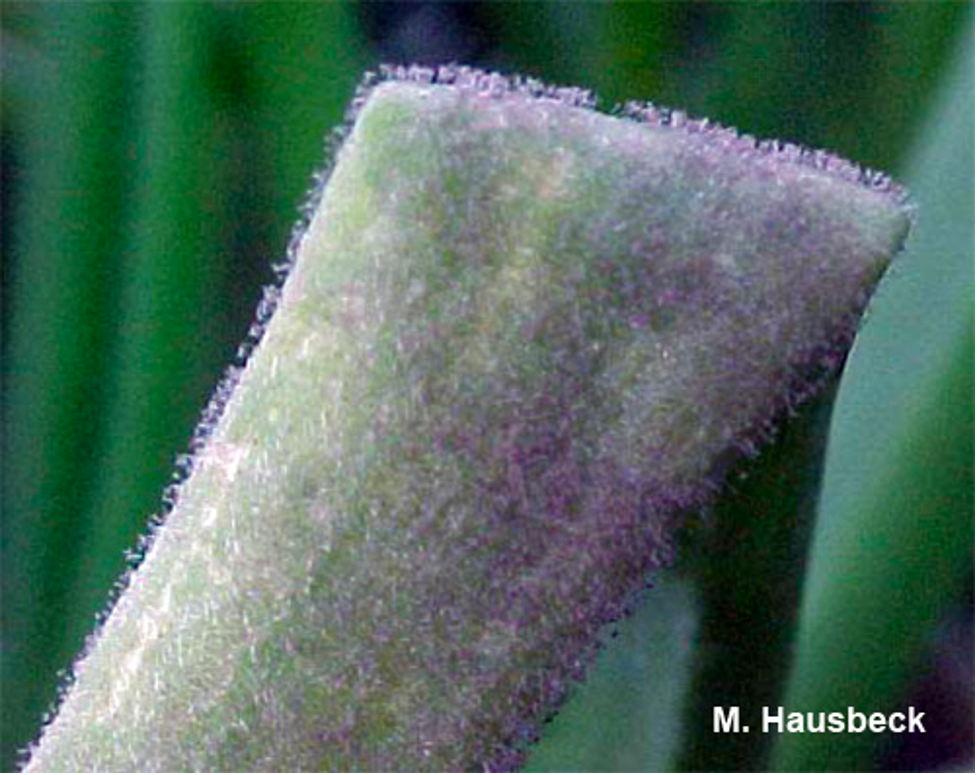
In both stemphylium and purple blotch, lesions often begin as brown, oval-shaped “thumbprint” spots, which grow larger with time and cause necrotic streaks along the affected leaf (fig. 5-6). These lesions eventually form spores, which disperse to neighboring leaves and plants. In purple blotch, as spores develop, the lesions typically turn purple, and in stemphylium leaf blight, they typically turn dark brown to black. However, differentiating between the two in the field is often nearly impossible, even for experts.
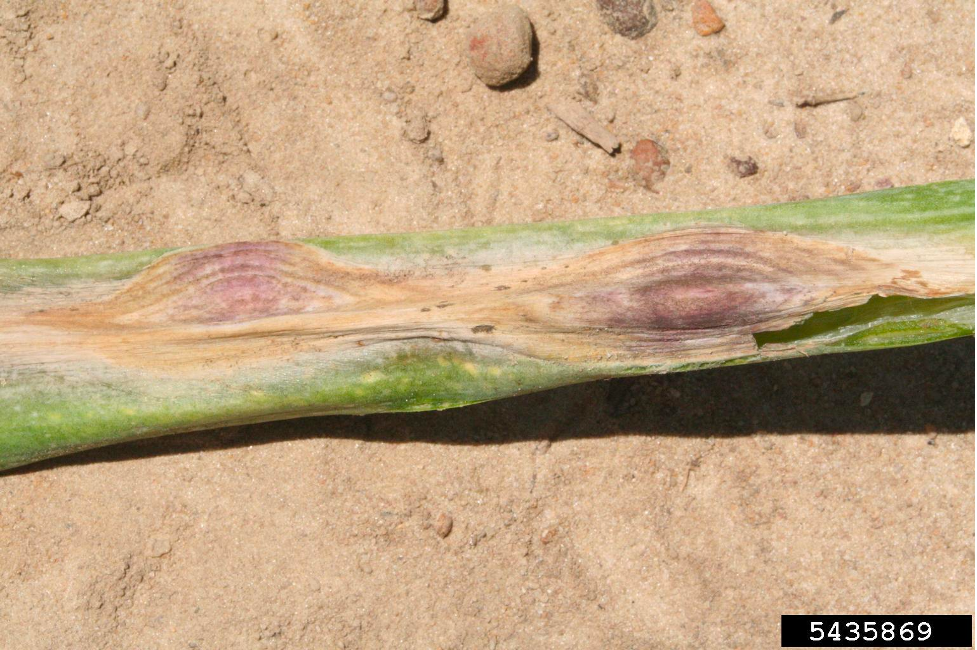
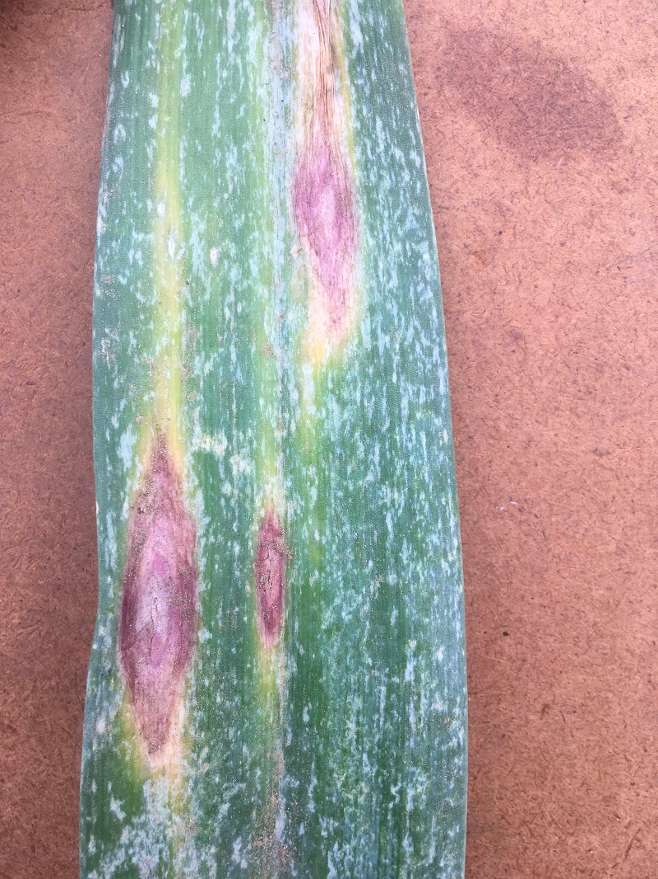
Cultural:
There are no varieties of allium that are resistant to botrytis leaf blight, downy mildew, purple blotch or stemphylium.
Use at least a three- or four-year rotation with all allium crops. In order to make your rotations most effective, consider whether it would help to also manage wild alliums in nearby areas, which can harbor these diseases in “off” years.” As with all disease management, plant and manage your crop to promote rapid drying.
Sanitation is key! While spores from these diseases can be dispersed by implements and insects, they are mostly spread by wind. That means any crop debris or culls from previous years left exposed anywhere on your farm or property can be a source of inoculum for another year of disease. Ensure that all allium crop debris is incorporated into the soil or deeply buried under compost as quickly as possible after harvest, and definitely well in advance of the next allium crop being planted. Culled onions should be deeply buried or disposed of. Culls can be composted, but home compost piles are often too small to reach the temperatures required to kill any conidia without very attentive management. Overwintering onions can act as a “green bridge” to carry allium diseases through the winter into the next season, and should be undertaken cautiously.
Managing thrips and preventing botrytis leaf spot early in the season can be great protectants against following infections of stemphylium leaf blight and purple blotch, by limiting the injury sites through which those fungi can enter. It’s also important to avoid over-applying nitrogen fertilizers in allium plantings, especially later in the season. Higher nitrogen levels in the plants, especially later in the season, is associated with more severe disease presentation in stemphylium leaf blight and purple blotch.
Organic pesticides (as a last resort):
Several biofungicide products may help to reduce infection when applied preventatively. These products work either by colonizing aboveground plant surfaces, effectively outcompeting disease spores before they can infect the plant, and/or by causing the plant to induce its systemic resistance. In other words, they can cue the plants to strengthen their defense mechanisms against pathogens. Products containing the bacteria Bacillus amyloliquefaciens, such as Double Nickel and Amplitude, as well as products containing Bacillus subtilis such as Serenade Opti, are labeled for control against Botrytis for both commercial growers and home gardeners. To decide when it may be appropriate to spray based on weather conditions, keep an eye on NEWA, which has models for botrytis leaf blight, downy mildew and purple blotch.
Please note: This information is for educational purposes. Any reference to commercial products, trade or brand names is for information only, and no endorsement or approval is intended. Pesticide registration status, approval for use in organic production and other aspects of labeling may change after the date of this writing. It is always best practice to check on a pesticide’s registration status with your state’s board of pesticide control, and for certified organic commercial producers to update their certification specialist if they are planning to use a material that is not already listed on their organic system plan. The use of any pesticide material, even those approved for use in organic production, carries risk — be sure to read and follow all label instructions. The label is the law. Pesticides labeled for home garden use are often not allowed for use in commercial production unless stated as such on the label.
Authors
Written by Mariam Taleb and Caleb Goossen
Source material
Steentjes, Maikel B. F., Scholten, Olga E., and Jan A. L. van Kan. March 2021. “Peeling the Onion: Towards a Better Understanding of Botrytis Diseases of Onion.” Phytopathology. DOI: 10.1094/PHYTO-06-20-0258-IA
Utah State Extension. “Purple Blotch, Stemphylium Leaf Blight” Utah Vegetable Guide. https://extension.usu.edu/vegetableguide/onion/purple-blotch-stemphylium-leaf-blight
Pscheidt, J.W., and Ocamb, C.M. March, 2023. “Onion (Allium cepa) Botrytis Leaf Blight.” Pacific Northwest Plant Disease Management Handbook. https://pnwhandbooks.org/plantdisease/host-disease/onion-allium-cepa-botrytis-leaf-blight
Swett, C.L. Aergerter, B.J., Turini, T.A. and A.I. Putman. Feb 2019. “Downy Mildew” UC IPM Pest Management Guidelines: Onion and Garlic. https://ipm.ucanr.edu/agriculture/onion-and-garlic/downy-mildew/
